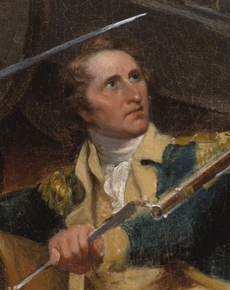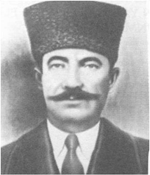 W
WJohn Bacon, was a leader of the Pine Robbers, a band of Loyalist guerrilla fighters who hid out in the Pine Barrens of south-central New Jersey and preyed upon Patriots toward the end of the American Revolutionary War. The group was responsible for the October 1782 Long Beach Island Massacre, which occurred after hostilities between the United States and Great Britain had been put on hold pending treaty negotiations. He and his band were relentlessly pursued thereafter. Bacon was killed the following March while resisting capture.
 W
WMartiniano Chilavert was a 19th-century Argentinian military officer who took part in the country's civil wars between the Unitarians and the Federales. Originally a Unitarian opponent of Federalist leader of Juan Manuel de Rosas, Chilavert turned to the Federalists after the Battle of Vuelta de Obligado. Chilavert was motivated by Rosas' resistance to the British and French and the other Unitarian leaders' alliance with foreign powers like the Empire of Brazil. The day after the Federalist defeat in the Battle of Caseros, which brought about the fall of Rosas regime, Chilavert was taken in custody. He was set for execution by shooting on the charge of treason upon direct orders of Unitarian leader Justo José de Urquiza. He was instead stabbed and killed with bayonets by the members of the firing squad after resisting to be shot in the back, a punishment commonly reserved for traitors.
 W
WLuis Daoíz y Torres was a Spanish artillery officer and one of the leaders of the Dos de Mayo Uprising that signalled the start of the Spanish War of Independence. Daoíz's surname is derived from the town of Aoiz in Navarre and he was descended from a long line of Spanish gentry with soldiering associations dating to the Reconquista. Daoíz's great grandfather married the daughter of the Count of Miraflores de los Angeles and Daoíz spent much of his early life in palaces owned by the family. He was born in Seville and, after receiving a Catholic education, trained at the Royal School of Artillery in Segovia. Daoíz saw action against the Moors in Spanish North Africa, where he was commended for his bravery and promoted to lieutenant. He also served against the French in the short-lived War of the Roussillon where he was captured. After refusing to serve in the French army, he was imprisoned.
 W
WJames W. Jackson was an ardent secessionist and the proprietor of the Marshall House, an inn located in the city of Alexandria, Virginia, at the beginning of the American Civil War. He is known for flying a large Confederate flag – the "Stars and Bars" variant – atop his inn that was visible to President Abraham Lincoln from Washington, D.C. and for killing Col. Elmer Ellsworth in an incident that marked the first conspicuous casualty and the first killing of a Union officer in the Civil War. Jackson was killed immediately after he killed Ellsworth. While losing their lives, both gained fame as martyrs to their respective causes.
 W
WHarrison H. Jeffords was the Colonel of the 4th Michigan Volunteer Infantry Regiment in the Union Army of the Potomac during the American Civil War. He was noted for his heroism on July 2, 1863 during the Battle of Gettysburg, in which he died while protecting the United States flag.
 W
WHugh Mercer was a Scottish soldier and physician who participated in the Seven Years' War and American Revolution. He initially served with the Jacobite forces of Bonnie Prince Charlie, and with the British forces during the Seven Years' War, and later became a brigadier general in the American Continental Army and a close friend to George Washington. Mercer died as a result of his wounds received at the Battle of Princeton and became a fallen hero as well as a rallying symbol of the American Revolution.
 W
WJuan Moreira is a well-known figure in the history of Argentina. An outlaw, gaucho and folk-hero, he is considered one of the most renowned Argentinian rural bandits.
 W
WRudolf Moroder-Lenèrt was an Austrian sculptor specializing in religious art, who was a member of the Moroder family of South Tyrol, which was notable for the many artists of repute they produced.
 W
WThe Rev. John Rosbrugh, also spelled Rosborough and Rosburgh, was a graduate of the College of New Jersey where he studied for the ministry and was ordained a Presbyterian minister. In 1776 he organized and became commander of the 3rd Northampton County, Pennsylvania militia, then accepted a commission as company chaplain. He was killed at the Battle of the Assunpink Creek, also known as the Second Battle of Trenton; the first U.S. chaplain killed in battle.
 W
WMehmed Said, better known as Şahin Bey, was the commander of the Turkish revolutionaries that were stationed in the city of Gaziantep during the Turkish War of Independence. He was of Chechen-Circassian descent.
 W
WJenaro Sánchez y Delgadillo was a Mexican Catholic priest who was executed by the Mexican military during the Cristero War in that country, born on September 19, 1886 and died on January 17, 1927. He is now honored as a martyr and saint by the Catholic Church.
 W
WHendrick Theyanoguin, whose name had several spelling variations, was an important Mohawk leader and member of the Bear Clan; he resided at Canajoharie or the Upper Mohawk Castle in colonial New York. He was a Speaker for the Mohawk Council. Hendrick formed a close alliance with Sir William Johnson, the Superintendent of Indian affairs in North America.